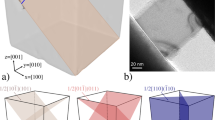Abstract
Dislocation nucleation in solid solutions of face-centered-cubic metallic materials was studied using nanoindentation. The effects of solute impurities in the copper–nickel system on the formation of dislocations in a previously dislocation-free region were demonstrated to be minimal. The shear stress required to nucleate dislocations in copper is approximately 1.6 GPa, while in nickel a 3.9 GPa shear stress is required. Changes in shear stress for nucleation track closely with changes in elastic modulus showing the nucleation stress is approximately 1/30 to 1/20 of the shear modulus. The expected solid-solution strengthening is identified within the same experimental method, demonstrating unambiguously the fact that solid-solution impurities in this system will impact the propagation of dislocations during plastic deformation but not alter the homogeneous nucleation of dislocations in these materials.
Similar content being viewed by others
References
C.A. Schuh and A.C. Lund: Application of nucleation theory to the rate dependence of incipient plasticity during nanoindentation. J. Mater. Res. 19, 2152 (2004).
S.A. Syed-Asif and J.B. Pethica: Nanoindentation creep of singlecrystal tungsten and gallium arsenide. Philos. Mag. A 76, 1105 (1997).
A.M. Minor, E.T. Lilleodden, E.A. Stach, and J.W. Morris: Direct observations of incipient plasticity during nanoindentation of Al. J. Mater. Res. 19, 176 (2004).
D.F. Bahr, D.E. Kramer, and W.W. Gerberich: Non-linear deformation mechanisms during nanoindentation. Acta Mater. 46, 3605 (1998).
A.B. Mann and J.B. Pethica: Role of atomic size asperities in the mechanical deformation of nanocontacts. Appl. Phys. Lett. 69, 907 (1996).
D.E. Jesson, K.M. Chen, S.J. Pennycook, T. Thundat, and R.J. Warmack: Crack-like sources of dislocation nucleation and multiplication in thin films. Science 268, 1161 (1995).
D. Tanguy, M. Mareschal, P.S. Lomdahl, T.C. Germann, B.L. Holian, and R. Ravelo: Dislocation nucleation induced by a shock wave in a perfect crystal: Molecular dynamics simulations and elastic calculations. Phys. Rev. B 68, 144111 (2003).
D.E. Kramer and T. Foecke: Transmission electron microscopy observations of deformation and fracture in nanolaminated Cu–Ni thin films. Philos. Mag. A 82, 3375 (2002).
C.A. Schuh, T.G. Nieh, and H. Iwasaki: The effect of solid solution W additions on the mechanical properties of nanocrystalline Ni. Acta Mater. 51, 431 (2003).
J.R. Rice: Dislocation nucleation from a crack tip. An analysis based on the Peierls concept. J. Mech. Phys. Solids 40, 239 (1992).
Y. Choi, K.J.V. Vliet, J. Li, and S. Suresh: Size effects on the onset of plastic deformation during nanoindentation of thin films and patterned lines. J. Appl. Phys. 94, 6050 (2003).
T. Zhu, J. Li, K.J.V. Vliet, S. Ogata, S. Yip, and S. Suresh: Predictive modeling of nanoindentation-induced homogeneous dislocation nucleation in copper. J. Mech. Phys. Solids 52, 691 (2004).
C.L. Kelchner, S.J. Plimpton, and J.C. Hamilton: Dislocation nucleation and defect structure during surface indentation. Phys. Rev. B 58, 11085 (1998).
W.W. Gerberich, N.I. Tymiak, J.C. Grunlan, M.F. Horstemeyer, and M.I. Baskes: Interpretation of indentation size effects. J. Appl. Mech. 69, 433 (2002).
A.H. Cotrell: Dislocations and Plastic Flow in Crystals (Oxford Press, Oxford, U.K., 1953), pp. 11–12, 53–54.
G.F. Vander Voort: Metallography Principles and Practice (McGraw-Hill, New York, 1984), p. 717.
W.W. Gerberich, J.C. Nelson, E.E. Lilleodden, P. Anderson, and J.T. Wyrobek: Indentation induced dislocation nucleation: The initial yield point. Acta Mater. 44, 3585 (1996).
K.L. Johnson: Contact Mechanics (Cambridge University Press, New York, 1985), pp. 90–104.
W.C. Oliver and G.M. Pharr: An improved technique for determining hardness and elastic modulus using load and displacement sensing indentation experiments. J. Mater. Res. 7, 1564 (1992).
S. Suresh, T.G. Nieh, and B.W. Choi: Nano-indentation of copper thin films on silicon substrates. Scripta Mater. 41, 951 (1999).
J.P. Hirth, and J. Lothe: Theory of Dislocations, 2nd ed. (Krieger Publishing, Miami, FL, 1992), pp. 681–685.
M. Pang, D.F. Bahr, and K.G. Lynn: Effects of Zn addition and thermal annealing on yield phenomena of CdTe and Cd0.96Zn0.04Te single crystals by nanoindentation. Appl. Phys. Lett. 82, 1200 (2003).
Author information
Authors and Affiliations
Corresponding author
Rights and permissions
About this article
Cite this article
Bahr, D.F., Vasquez, G. Effect of solid solution impurities on dislocation nucleation during nanoindentation. Journal of Materials Research 20, 1947–1951 (2005). https://doi.org/10.1557/JMR.2005.0244
Received:
Accepted:
Published:
Issue Date:
DOI: https://doi.org/10.1557/JMR.2005.0244




